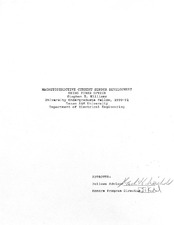| dc.contributor.advisor | Weichold, Mark H. | |
| dc.creator | Williams, Stephen E. | |
| dc.date.accessioned | 2022-04-04T13:50:36Z | |
| dc.date.available | 2022-04-04T13:50:36Z | |
| dc.date.issued | 1991 | |
| dc.identifier.uri | https://hdl.handle.net/1969.1/CAPSTONE-WeghorstG_1982 | |
| dc.description | Program year: 1990/1991 | en |
| dc.description | Digitized from print original stored in HDR | en |
| dc.description.abstract | The ability to develop a fiber optic current sensor utilizing the magnetostrictive characteristics of nickel (Ni) has been proven. A Mach-Zehnder interferometer, which had a 2. 5-μm layer of Ni 15-cm long on its sensing arm, was found to accurately detect magnetic fields as small as 40 gauss. Ni was deposited via DC sputter direcily onto the SiO₂ buffer of the 1.3-μm single mode fiber. There is sufficient evidence that a two-step process involving the electron-beam deposition of 274 Å of chromium (Cr), 226 Å of Ni, and a Ni electroplate of greater than 10-μm thickness can be achieved. Such a deposition should yield a 16-fold increase in sensor sensitivity. | en |
| dc.format.extent | 37 pages | en |
| dc.format.medium | electronic | en |
| dc.format.mimetype | application/pdf | |
| dc.subject | current sensor | en |
| dc.subject | nickel | en |
| dc.subject | sensor sensitivity | en |
| dc.subject | fiber optic | en |
| dc.title | Magnetostrictive Current Sensor Development Using Fiber Optics | en |
| dc.title.alternative | MAGNETOSTRICTIVE CURRENT SENSOR DEVELOPMENT USING FIBER OPTICS | en |
| dc.type | Thesis | en |
| thesis.degree.department | Electrical Engineering | en |
| thesis.degree.grantor | University Undergraduate Fellow | en |
| thesis.degree.level | Undergraduate | en |
| dc.type.material | text | en |


